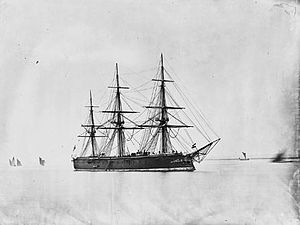SMS König Wilhelm (1868)

König Wilhelm in Gravesend, England
|
|
| Class overview | |
|---|---|
| Operators: |
|
| Preceded by: | Kronprinz |
| Succeeded by: | Hansa |
| Built: | 1865—69 |
| Completed: | 1 |
| Scrapped: | 1 |
| History | |
|
|
|
| Name: | SMS König Wilhelm |
| Namesake: | William I (1797–1888), King of Prussia (1861–1871), later William I, German Emperor (1871–1888) |
| Builder: | Thames Iron Works, Leamouth, London |
| Laid down: | 1865 |
| Launched: | 25 April 1868 |
| Commissioned: | 20 February 1869 |
| Struck: | 4 January 1921 |
| Fate: | Sold for scrapping, 1921 |
| Notes: | Served as barracks ship 1904–1907, then as training ship |
| General characteristics | |
| Type: | Armored frigate |
| Displacement: |
|
| Length: | 112.20 m (368 ft 1 in) |
| Beam: | 18.30 m (60 ft) |
| Draft: | 8.56 m (28 ft 1 in) |
| Installed power: | 8,440 ihp (6,290 kW) |
| Propulsion: |
|
| Sail plan: | 2,600 m2 (28,000 sq ft) (removed 1895–1896) |
| Speed: | 14.7 knots (27.2 km/h; 16.9 mph) |
| Range: | 1,300 nmi (2,400 km; 1,500 mi) at 10 knots (19 km/h; 12 mph) |
| Boats & landing craft carried: |
10 |
| Crew: |
|
| Armament: |
|
| Armor: |
|
SMS König Wilhelm (King William) was an armored frigate of the Prussian and later the German Imperial Navy. The ship was laid down in 1865 at the Thames Ironworks shipyard in London, originally under the name Fatih for the Ottoman Empire. She was purchased by Prussia in February 1867, launched in April 1868, and commissioned into the Prussian Navy in February 1869. The ship was the fifth ironclad ordered by the Prussian Navy, after Arminius, Prinz Adalbert, Friedrich Carl, and Kronprinz. She was built as an armored frigate, armed with a main battery of sixteen 24 cm (9.4 in) and five 21 cm (8.3 in) guns; several smaller guns and torpedo tubes were added later in her career.
The ship was for a time the largest and most powerful warship in the German navy; she served as its flagship during the Franco-Prussian War in 1870–1871, though engine troubles prevented the ship from seeing action. In 1878, the ship accidentally rammed and sank the ironclad Grosser Kurfürst, with great loss of life. König Wilhelm was converted into an armored cruiser in 1895–1896; by early 1904, however, she had been superseded by newer vessels. In May of that year, she was placed out of active service and used as a floating barracks and training ship, a role she held through World War I. In 1921, the ship was ultimately broken up for scrap, after a career spanning 52 years and three German states.
König Wilhelm was 108.60 meters (356 ft 4 in) long at the waterline and 112.20 m (368 ft 1 in) long overall. She had a beam of 18.30 m (60 ft) and a draft of 8.56 m (28 ft 1 in) forward and 8.12 m (26 ft 8 in) aft. The ship was designed to displace 9,757 metric tons (9,603 long tons) at a normal loading, and up to 10,761 t (10,591 long tons) with a combat load. The ship's hull was constructed with transverse and longitudinal iron frames. It contained eleven watertight compartments and a double bottom that ran for 70 percent of the length of the vessel.
...
Wikipedia
